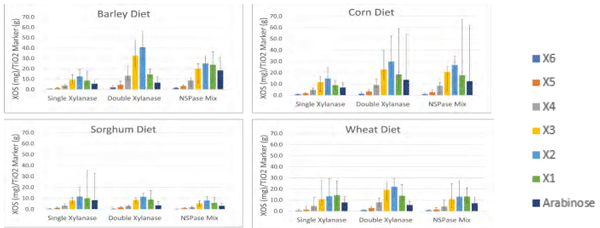Effects of Xylanase Dosage and Mixed NSPases on the in-vivo Production of Xylo-Oligosaccharides in Broilers Fed Barley, Corn, Sorghum and Wheat-Based Diets
Published: September 11, 2023
By: A. D. WALLACE 1, R. HOPCROFT 2 and N. K. MORGAN 1 / 1 University of New England, Australia; 2 Inghams Enterprises Pty Limited, Australia.
There is increasing evidence that supplementing small amounts of prebiotic xylo-oligosaccharides (XOS) into poultry diets has positive effects on bird performance and gastrointestinal health. Soluble XOS that reach the caeca intact are utilised by beneficial bacteria, inducing positive effects such as increased production of short chain fatty acids (Aachary & Prapulla, 2011). Commercial endo-xylanases are added to diets to reduce digesta viscosity, but have the side effect of producing these favorable XOS, namely xylobiose (X2), and to a lesser degree xylotriose (X3) and xylotetraose (X4). The aim of this study was to examine if production of XOS from dietary xylan could be increased by feeding a higher dosage of xylanase, or by feeding a cocktail of xylanase and other non-starch polysaccharide degrading enzymes (NSPase Mix). Cobb 500 mixed-sex broilers (n =720) were distributed into 72 pens (10 birds per pen, 6 pens per treatment) and fed commercial-type barley-, corn-, sorghum- or wheat-based diets, supplemented with either a recommended dose of xylanase (16,000 BXU/kg), a double dose of xylanase (32,000 BXU/kg) (Econase XT 5P, AB Vista) or a xylanase (16,000 BXU/kg) and NSPase mix, containing beta-glucanase (20,000 U/kg) (Econase GT, AB Vista), cellulase (2000 U/kg) (SigmaAldrich), pectinase (1400 U/kg), mannanase (250 U/kg), galactanase (20 U/kg) and arabinofuranosidase (10,000U/kg) (Deltagen). At day 35, digesta samples from the ileum were collected and analysed for XOS using Liquid Chromatography Mass Spectrometry.
Figure 1 – XOS measured in ileum digesta (D35) from broilers fed commercial-type barley, corn, sorghum, or wheat-based diets supplemented with either single xylanase (16,000 BXU/kg), double xylanase (32,000 BXU/kg) or single xylanase and NSPases mix.

In the sorghum- and wheat-based diets, no increase in XOS was observed when diets were supplemented with the NSPase mix as compared to xylanase alone. This suggests that xylanase activity was not inhibited by other NSP in these diets, or that the NSPases were ineffective. A slight change in XOS profile towards X2 and X3 was observed in the wheat-based diets with double xylanase application. This may indicate that all enzyme hydrolysable substrates were being depleted. In the barley- and cornbased diets, significant increase in all XOS production was observed with the increased xylanase dose. The NSPase mix improved XOS production in the barley- and corn-based diets. This implies that other NSPs in these diets may inhibit xylanase activity, and presence of additional NSPases may be beneficial.
ACKNOWLEDGEMENTS: The authors are grateful for financial support from AgriFutures Australia Chicken Meat Program. Aachary AA & Prapulla SG (2011) Comprehensive Reviews in Food Science and Food Safety, 10(1): 2–16.
Presented at the 33th Annual Australian Poultry Science Symposium 2022. For information on the next edition, click here.
Content from the event:
Related topics:
Authors:
University of New England
University of New England
Recommend
Comment
Share

Would you like to discuss another topic? Create a new post to engage with experts in the community.








.jpg&w=3840&q=75)